Tutorial Questions
VerifiedAdded on 2023/01/10
|7
|1884
|100
AI Summary
This document contains tutorial questions and answers on various topics. It covers conversion cycle, control weaknesses, resource event agent, audit of financial records, and implementation of a new information system.
Contribute Materials
Your contribution can guide someone’s learning journey. Share your
documents today.
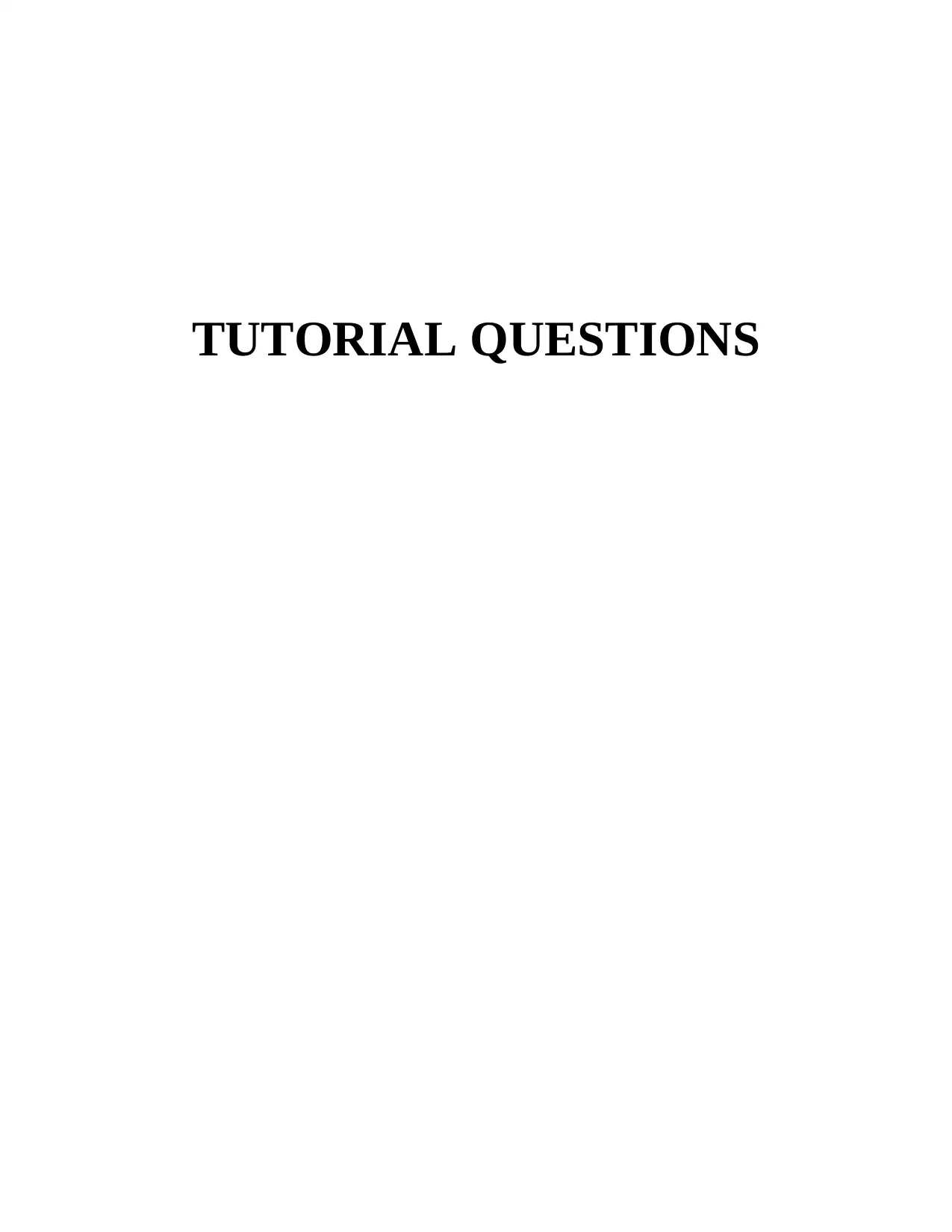
TUTORIAL QUESTIONS
Secure Best Marks with AI Grader
Need help grading? Try our AI Grader for instant feedback on your assignments.
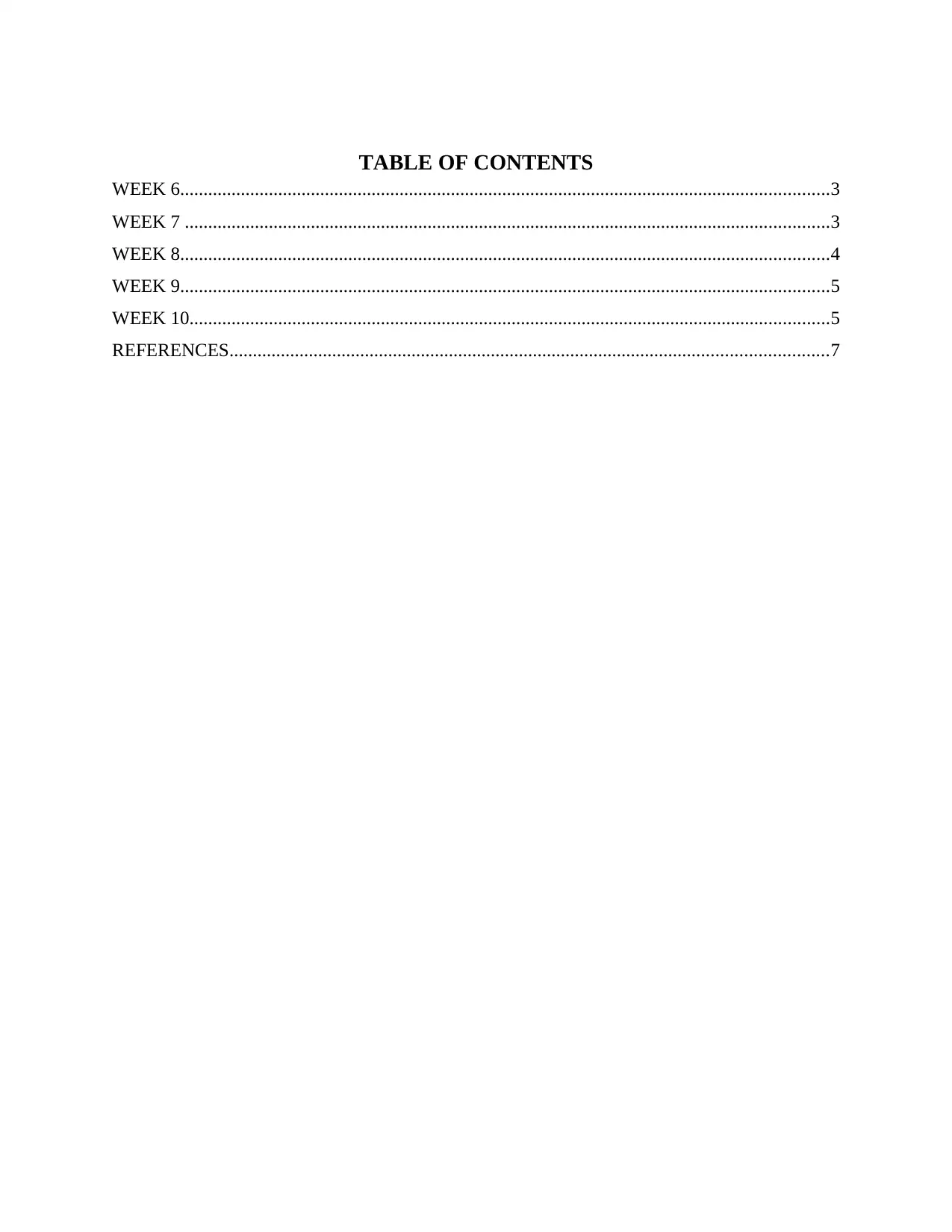
TABLE OF CONTENTS
WEEK 6...........................................................................................................................................3
WEEK 7 ..........................................................................................................................................3
WEEK 8...........................................................................................................................................4
WEEK 9...........................................................................................................................................5
WEEK 10.........................................................................................................................................5
REFERENCES................................................................................................................................7
WEEK 6...........................................................................................................................................3
WEEK 7 ..........................................................................................................................................3
WEEK 8...........................................................................................................................................4
WEEK 9...........................................................................................................................................5
WEEK 10.........................................................................................................................................5
REFERENCES................................................................................................................................7
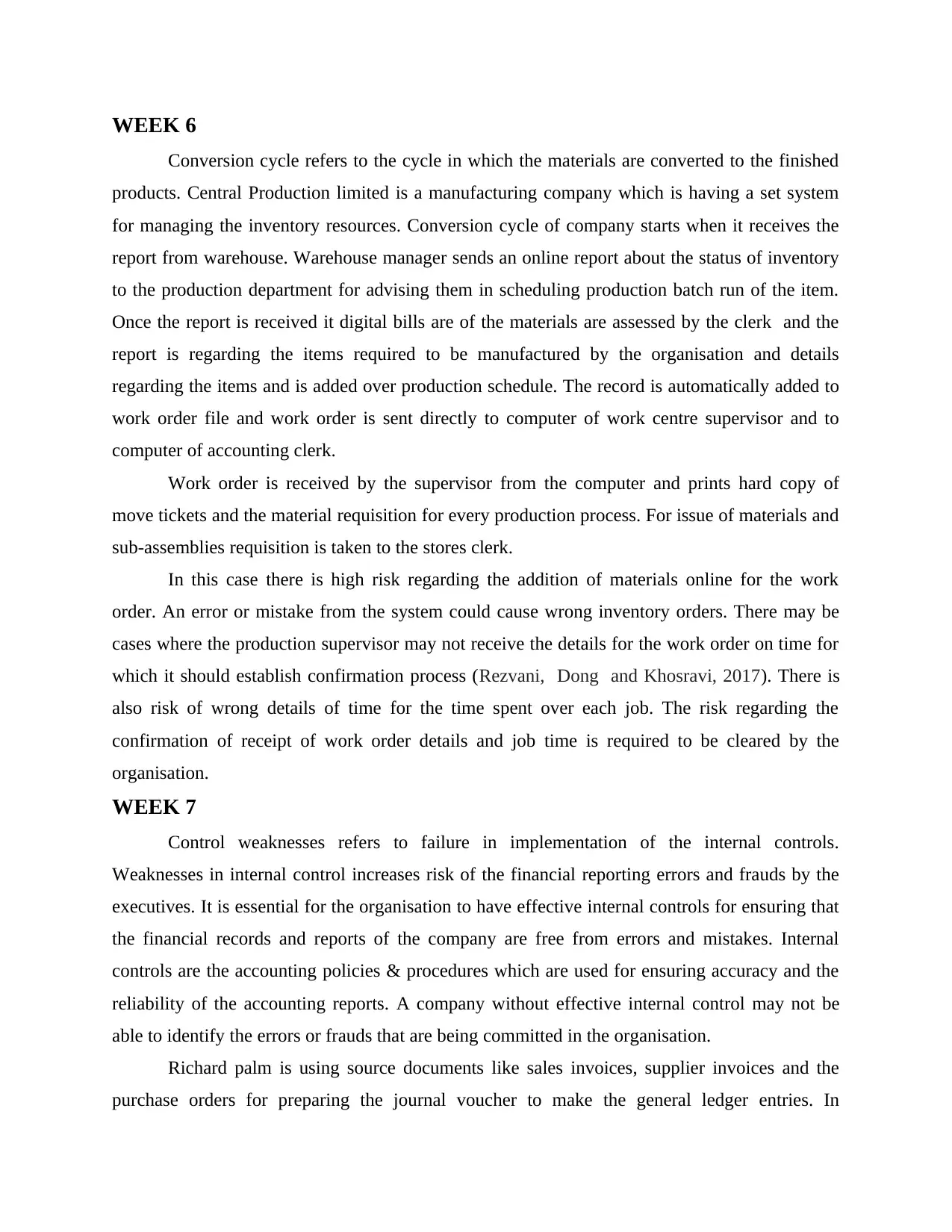
WEEK 6
Conversion cycle refers to the cycle in which the materials are converted to the finished
products. Central Production limited is a manufacturing company which is having a set system
for managing the inventory resources. Conversion cycle of company starts when it receives the
report from warehouse. Warehouse manager sends an online report about the status of inventory
to the production department for advising them in scheduling production batch run of the item.
Once the report is received it digital bills are of the materials are assessed by the clerk and the
report is regarding the items required to be manufactured by the organisation and details
regarding the items and is added over production schedule. The record is automatically added to
work order file and work order is sent directly to computer of work centre supervisor and to
computer of accounting clerk.
Work order is received by the supervisor from the computer and prints hard copy of
move tickets and the material requisition for every production process. For issue of materials and
sub-assemblies requisition is taken to the stores clerk.
In this case there is high risk regarding the addition of materials online for the work
order. An error or mistake from the system could cause wrong inventory orders. There may be
cases where the production supervisor may not receive the details for the work order on time for
which it should establish confirmation process (Rezvani, Dong and Khosravi, 2017). There is
also risk of wrong details of time for the time spent over each job. The risk regarding the
confirmation of receipt of work order details and job time is required to be cleared by the
organisation.
WEEK 7
Control weaknesses refers to failure in implementation of the internal controls.
Weaknesses in internal control increases risk of the financial reporting errors and frauds by the
executives. It is essential for the organisation to have effective internal controls for ensuring that
the financial records and reports of the company are free from errors and mistakes. Internal
controls are the accounting policies & procedures which are used for ensuring accuracy and the
reliability of the accounting reports. A company without effective internal control may not be
able to identify the errors or frauds that are being committed in the organisation.
Richard palm is using source documents like sales invoices, supplier invoices and the
purchase orders for preparing the journal voucher to make the general ledger entries. In
Conversion cycle refers to the cycle in which the materials are converted to the finished
products. Central Production limited is a manufacturing company which is having a set system
for managing the inventory resources. Conversion cycle of company starts when it receives the
report from warehouse. Warehouse manager sends an online report about the status of inventory
to the production department for advising them in scheduling production batch run of the item.
Once the report is received it digital bills are of the materials are assessed by the clerk and the
report is regarding the items required to be manufactured by the organisation and details
regarding the items and is added over production schedule. The record is automatically added to
work order file and work order is sent directly to computer of work centre supervisor and to
computer of accounting clerk.
Work order is received by the supervisor from the computer and prints hard copy of
move tickets and the material requisition for every production process. For issue of materials and
sub-assemblies requisition is taken to the stores clerk.
In this case there is high risk regarding the addition of materials online for the work
order. An error or mistake from the system could cause wrong inventory orders. There may be
cases where the production supervisor may not receive the details for the work order on time for
which it should establish confirmation process (Rezvani, Dong and Khosravi, 2017). There is
also risk of wrong details of time for the time spent over each job. The risk regarding the
confirmation of receipt of work order details and job time is required to be cleared by the
organisation.
WEEK 7
Control weaknesses refers to failure in implementation of the internal controls.
Weaknesses in internal control increases risk of the financial reporting errors and frauds by the
executives. It is essential for the organisation to have effective internal controls for ensuring that
the financial records and reports of the company are free from errors and mistakes. Internal
controls are the accounting policies & procedures which are used for ensuring accuracy and the
reliability of the accounting reports. A company without effective internal control may not be
able to identify the errors or frauds that are being committed in the organisation.
Richard palm is using source documents like sales invoices, supplier invoices and the
purchase orders for preparing the journal voucher to make the general ledger entries. In
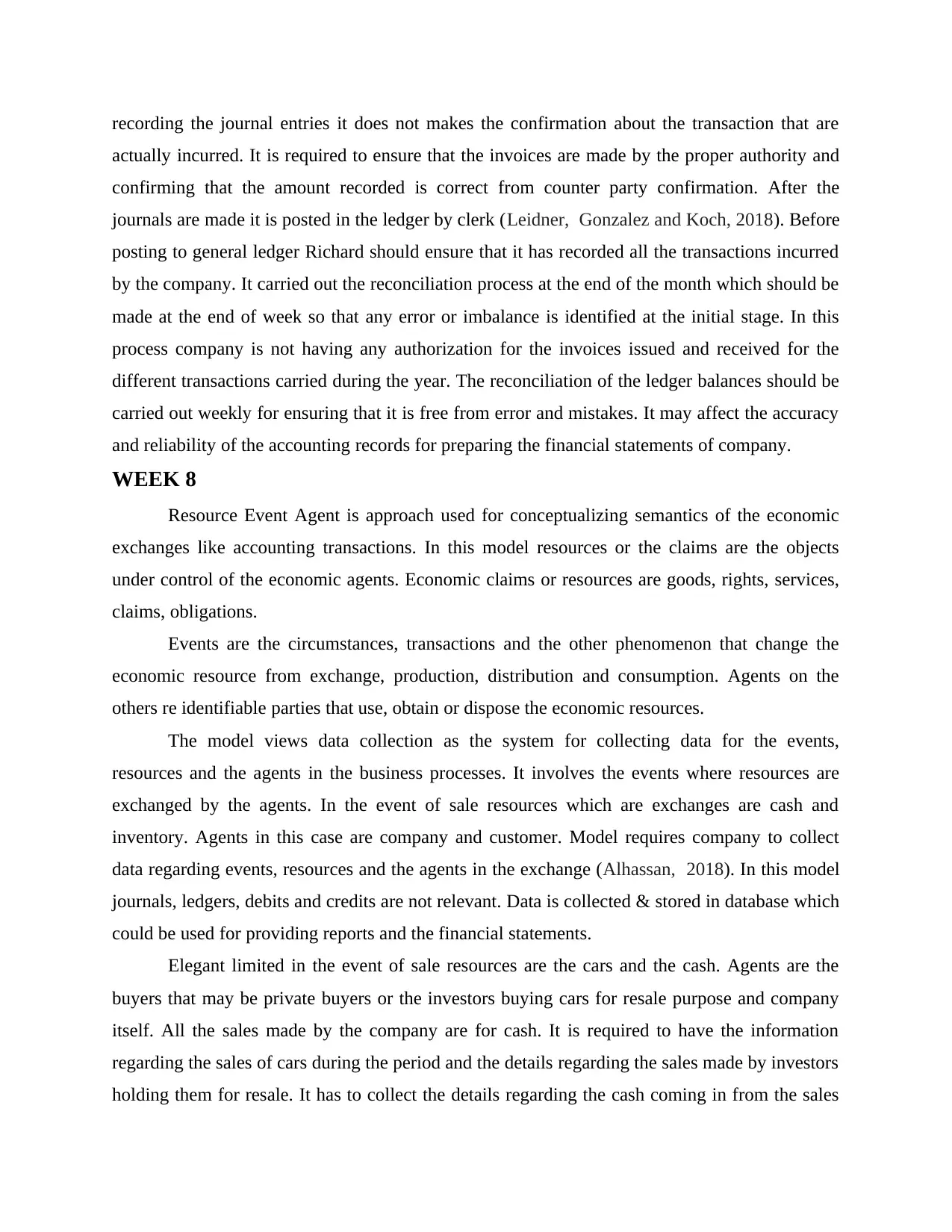
recording the journal entries it does not makes the confirmation about the transaction that are
actually incurred. It is required to ensure that the invoices are made by the proper authority and
confirming that the amount recorded is correct from counter party confirmation. After the
journals are made it is posted in the ledger by clerk (Leidner, Gonzalez and Koch, 2018). Before
posting to general ledger Richard should ensure that it has recorded all the transactions incurred
by the company. It carried out the reconciliation process at the end of the month which should be
made at the end of week so that any error or imbalance is identified at the initial stage. In this
process company is not having any authorization for the invoices issued and received for the
different transactions carried during the year. The reconciliation of the ledger balances should be
carried out weekly for ensuring that it is free from error and mistakes. It may affect the accuracy
and reliability of the accounting records for preparing the financial statements of company.
WEEK 8
Resource Event Agent is approach used for conceptualizing semantics of the economic
exchanges like accounting transactions. In this model resources or the claims are the objects
under control of the economic agents. Economic claims or resources are goods, rights, services,
claims, obligations.
Events are the circumstances, transactions and the other phenomenon that change the
economic resource from exchange, production, distribution and consumption. Agents on the
others re identifiable parties that use, obtain or dispose the economic resources.
The model views data collection as the system for collecting data for the events,
resources and the agents in the business processes. It involves the events where resources are
exchanged by the agents. In the event of sale resources which are exchanges are cash and
inventory. Agents in this case are company and customer. Model requires company to collect
data regarding events, resources and the agents in the exchange (Alhassan, 2018). In this model
journals, ledgers, debits and credits are not relevant. Data is collected & stored in database which
could be used for providing reports and the financial statements.
Elegant limited in the event of sale resources are the cars and the cash. Agents are the
buyers that may be private buyers or the investors buying cars for resale purpose and company
itself. All the sales made by the company are for cash. It is required to have the information
regarding the sales of cars during the period and the details regarding the sales made by investors
holding them for resale. It has to collect the details regarding the cash coming in from the sales
actually incurred. It is required to ensure that the invoices are made by the proper authority and
confirming that the amount recorded is correct from counter party confirmation. After the
journals are made it is posted in the ledger by clerk (Leidner, Gonzalez and Koch, 2018). Before
posting to general ledger Richard should ensure that it has recorded all the transactions incurred
by the company. It carried out the reconciliation process at the end of the month which should be
made at the end of week so that any error or imbalance is identified at the initial stage. In this
process company is not having any authorization for the invoices issued and received for the
different transactions carried during the year. The reconciliation of the ledger balances should be
carried out weekly for ensuring that it is free from error and mistakes. It may affect the accuracy
and reliability of the accounting records for preparing the financial statements of company.
WEEK 8
Resource Event Agent is approach used for conceptualizing semantics of the economic
exchanges like accounting transactions. In this model resources or the claims are the objects
under control of the economic agents. Economic claims or resources are goods, rights, services,
claims, obligations.
Events are the circumstances, transactions and the other phenomenon that change the
economic resource from exchange, production, distribution and consumption. Agents on the
others re identifiable parties that use, obtain or dispose the economic resources.
The model views data collection as the system for collecting data for the events,
resources and the agents in the business processes. It involves the events where resources are
exchanged by the agents. In the event of sale resources which are exchanges are cash and
inventory. Agents in this case are company and customer. Model requires company to collect
data regarding events, resources and the agents in the exchange (Alhassan, 2018). In this model
journals, ledgers, debits and credits are not relevant. Data is collected & stored in database which
could be used for providing reports and the financial statements.
Elegant limited in the event of sale resources are the cars and the cash. Agents are the
buyers that may be private buyers or the investors buying cars for resale purpose and company
itself. All the sales made by the company are for cash. It is required to have the information
regarding the sales of cars during the period and the details regarding the sales made by investors
holding them for resale. It has to collect the details regarding the cash coming in from the sales
Secure Best Marks with AI Grader
Need help grading? Try our AI Grader for instant feedback on your assignments.
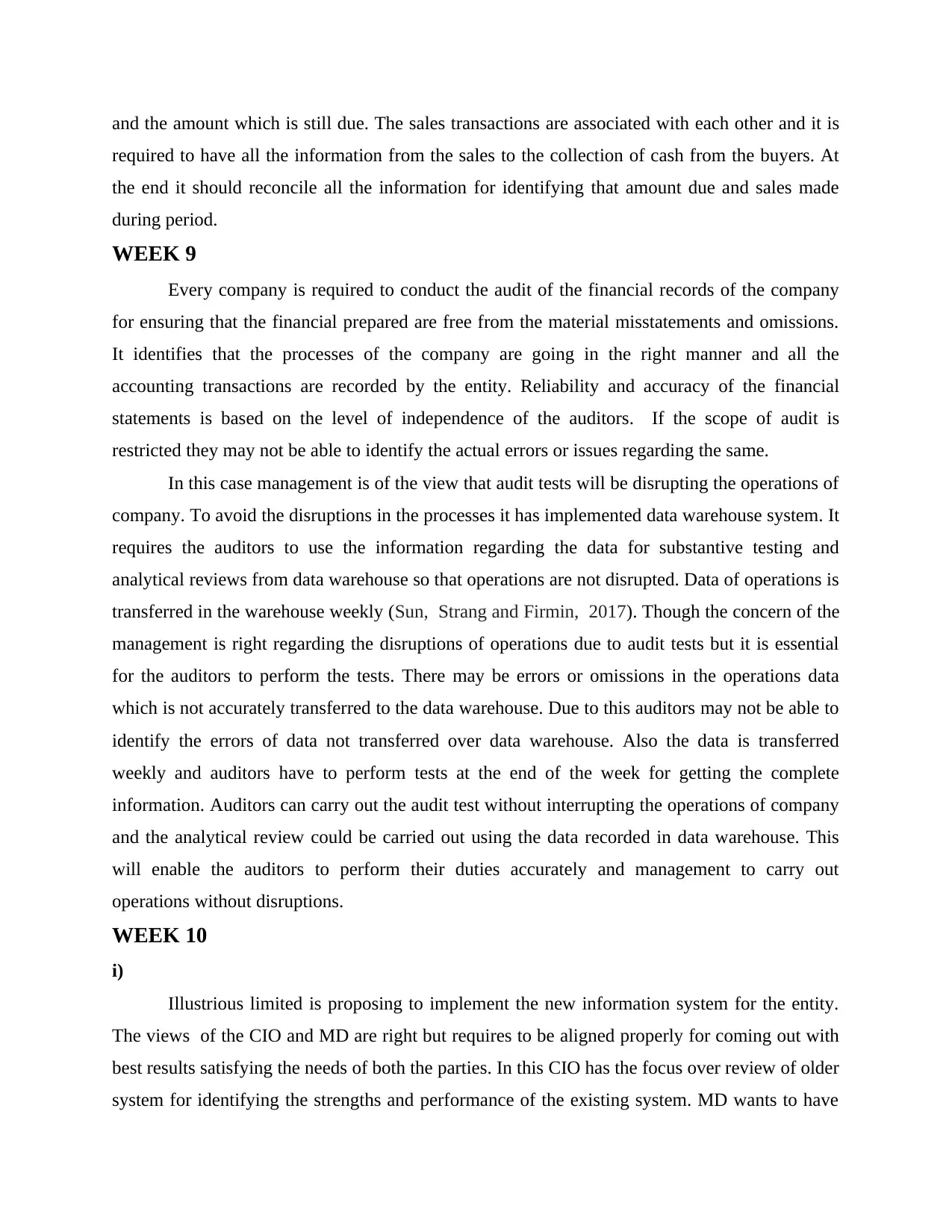
and the amount which is still due. The sales transactions are associated with each other and it is
required to have all the information from the sales to the collection of cash from the buyers. At
the end it should reconcile all the information for identifying that amount due and sales made
during period.
WEEK 9
Every company is required to conduct the audit of the financial records of the company
for ensuring that the financial prepared are free from the material misstatements and omissions.
It identifies that the processes of the company are going in the right manner and all the
accounting transactions are recorded by the entity. Reliability and accuracy of the financial
statements is based on the level of independence of the auditors. If the scope of audit is
restricted they may not be able to identify the actual errors or issues regarding the same.
In this case management is of the view that audit tests will be disrupting the operations of
company. To avoid the disruptions in the processes it has implemented data warehouse system. It
requires the auditors to use the information regarding the data for substantive testing and
analytical reviews from data warehouse so that operations are not disrupted. Data of operations is
transferred in the warehouse weekly (Sun, Strang and Firmin, 2017). Though the concern of the
management is right regarding the disruptions of operations due to audit tests but it is essential
for the auditors to perform the tests. There may be errors or omissions in the operations data
which is not accurately transferred to the data warehouse. Due to this auditors may not be able to
identify the errors of data not transferred over data warehouse. Also the data is transferred
weekly and auditors have to perform tests at the end of the week for getting the complete
information. Auditors can carry out the audit test without interrupting the operations of company
and the analytical review could be carried out using the data recorded in data warehouse. This
will enable the auditors to perform their duties accurately and management to carry out
operations without disruptions.
WEEK 10
i)
Illustrious limited is proposing to implement the new information system for the entity.
The views of the CIO and MD are right but requires to be aligned properly for coming out with
best results satisfying the needs of both the parties. In this CIO has the focus over review of older
system for identifying the strengths and performance of the existing system. MD wants to have
required to have all the information from the sales to the collection of cash from the buyers. At
the end it should reconcile all the information for identifying that amount due and sales made
during period.
WEEK 9
Every company is required to conduct the audit of the financial records of the company
for ensuring that the financial prepared are free from the material misstatements and omissions.
It identifies that the processes of the company are going in the right manner and all the
accounting transactions are recorded by the entity. Reliability and accuracy of the financial
statements is based on the level of independence of the auditors. If the scope of audit is
restricted they may not be able to identify the actual errors or issues regarding the same.
In this case management is of the view that audit tests will be disrupting the operations of
company. To avoid the disruptions in the processes it has implemented data warehouse system. It
requires the auditors to use the information regarding the data for substantive testing and
analytical reviews from data warehouse so that operations are not disrupted. Data of operations is
transferred in the warehouse weekly (Sun, Strang and Firmin, 2017). Though the concern of the
management is right regarding the disruptions of operations due to audit tests but it is essential
for the auditors to perform the tests. There may be errors or omissions in the operations data
which is not accurately transferred to the data warehouse. Due to this auditors may not be able to
identify the errors of data not transferred over data warehouse. Also the data is transferred
weekly and auditors have to perform tests at the end of the week for getting the complete
information. Auditors can carry out the audit test without interrupting the operations of company
and the analytical review could be carried out using the data recorded in data warehouse. This
will enable the auditors to perform their duties accurately and management to carry out
operations without disruptions.
WEEK 10
i)
Illustrious limited is proposing to implement the new information system for the entity.
The views of the CIO and MD are right but requires to be aligned properly for coming out with
best results satisfying the needs of both the parties. In this CIO has the focus over review of older
system for identifying the strengths and performance of the existing system. MD wants to have
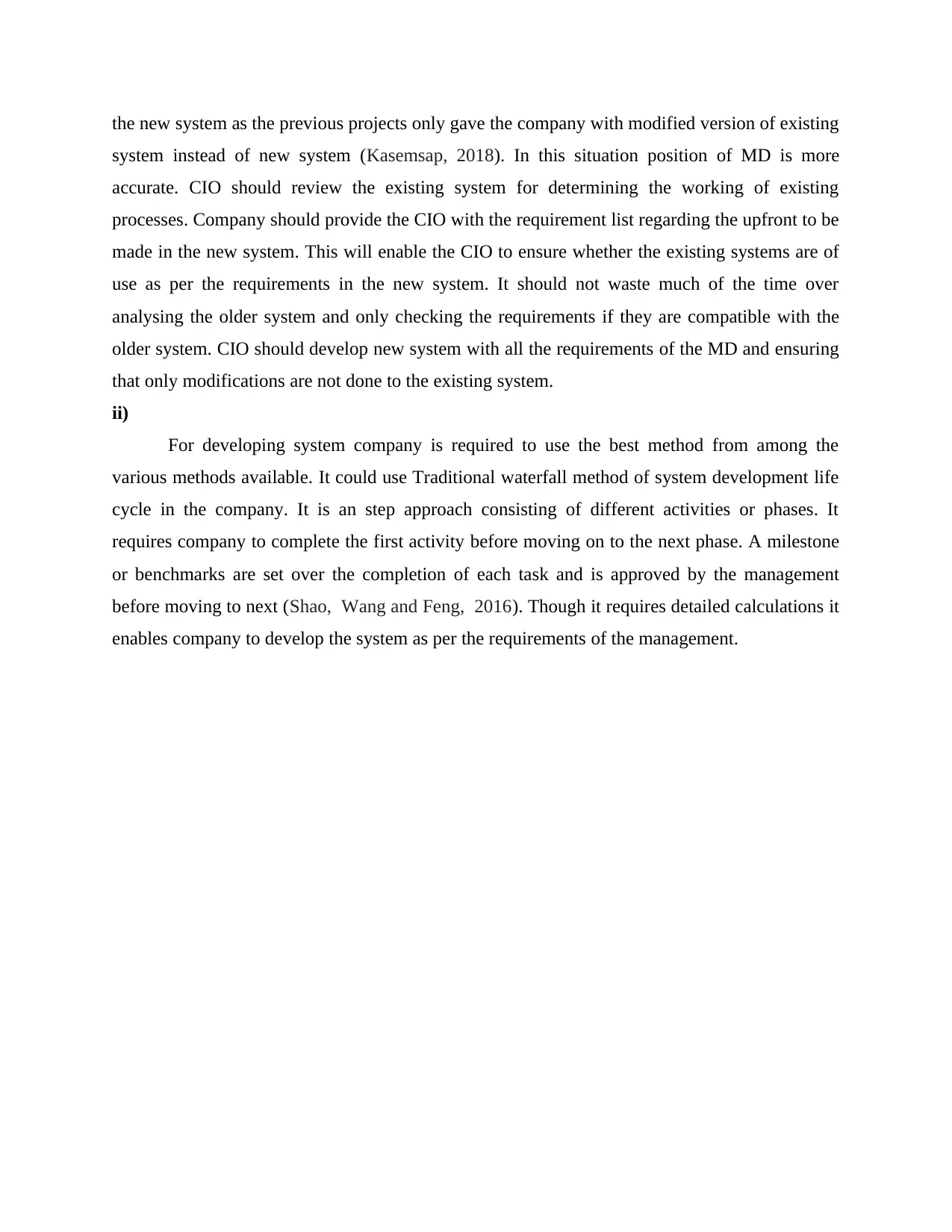
the new system as the previous projects only gave the company with modified version of existing
system instead of new system (Kasemsap, 2018). In this situation position of MD is more
accurate. CIO should review the existing system for determining the working of existing
processes. Company should provide the CIO with the requirement list regarding the upfront to be
made in the new system. This will enable the CIO to ensure whether the existing systems are of
use as per the requirements in the new system. It should not waste much of the time over
analysing the older system and only checking the requirements if they are compatible with the
older system. CIO should develop new system with all the requirements of the MD and ensuring
that only modifications are not done to the existing system.
ii)
For developing system company is required to use the best method from among the
various methods available. It could use Traditional waterfall method of system development life
cycle in the company. It is an step approach consisting of different activities or phases. It
requires company to complete the first activity before moving on to the next phase. A milestone
or benchmarks are set over the completion of each task and is approved by the management
before moving to next (Shao, Wang and Feng, 2016). Though it requires detailed calculations it
enables company to develop the system as per the requirements of the management.
system instead of new system (Kasemsap, 2018). In this situation position of MD is more
accurate. CIO should review the existing system for determining the working of existing
processes. Company should provide the CIO with the requirement list regarding the upfront to be
made in the new system. This will enable the CIO to ensure whether the existing systems are of
use as per the requirements in the new system. It should not waste much of the time over
analysing the older system and only checking the requirements if they are compatible with the
older system. CIO should develop new system with all the requirements of the MD and ensuring
that only modifications are not done to the existing system.
ii)
For developing system company is required to use the best method from among the
various methods available. It could use Traditional waterfall method of system development life
cycle in the company. It is an step approach consisting of different activities or phases. It
requires company to complete the first activity before moving on to the next phase. A milestone
or benchmarks are set over the completion of each task and is approved by the management
before moving to next (Shao, Wang and Feng, 2016). Though it requires detailed calculations it
enables company to develop the system as per the requirements of the management.
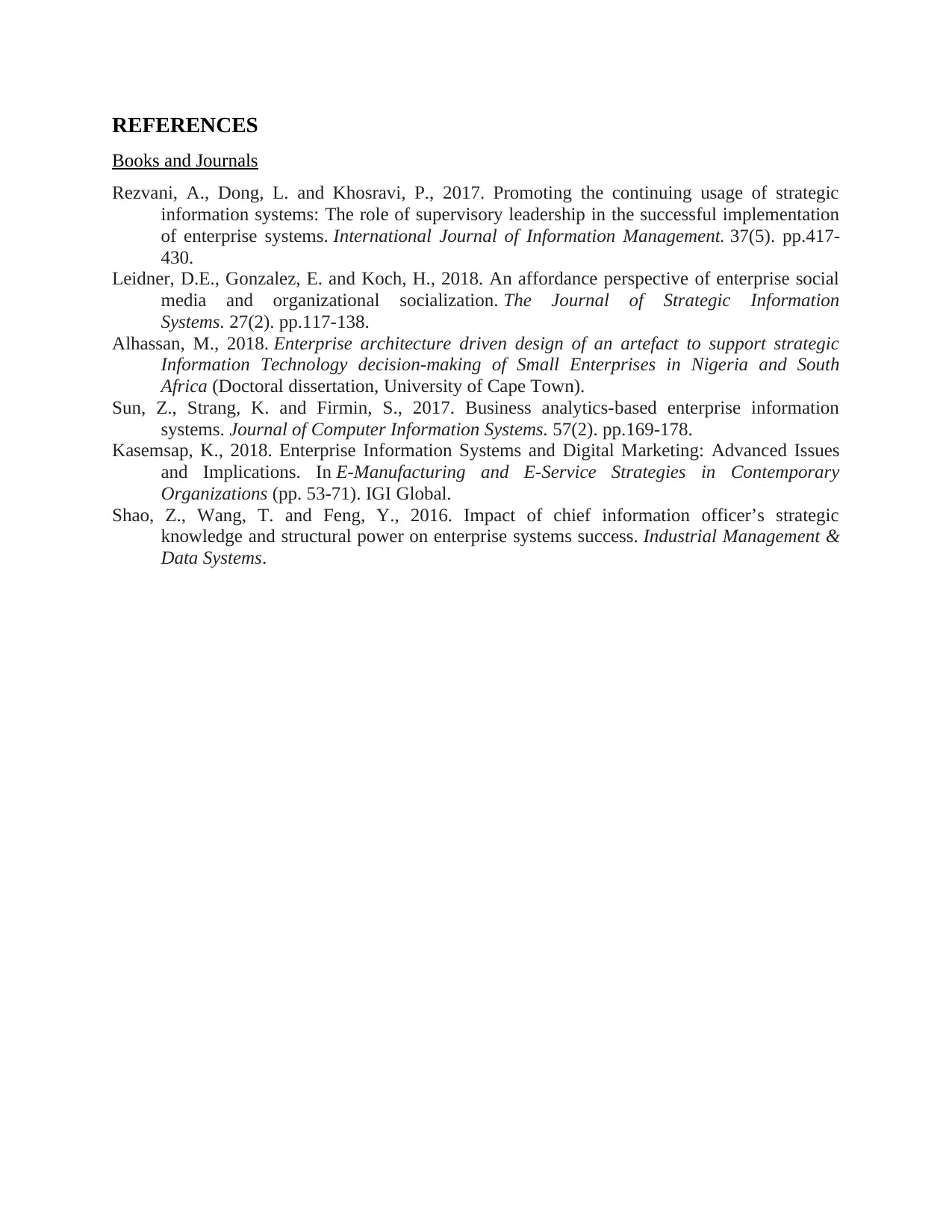
REFERENCES
Books and Journals
Rezvani, A., Dong, L. and Khosravi, P., 2017. Promoting the continuing usage of strategic
information systems: The role of supervisory leadership in the successful implementation
of enterprise systems. International Journal of Information Management. 37(5). pp.417-
430.
Leidner, D.E., Gonzalez, E. and Koch, H., 2018. An affordance perspective of enterprise social
media and organizational socialization. The Journal of Strategic Information
Systems. 27(2). pp.117-138.
Alhassan, M., 2018. Enterprise architecture driven design of an artefact to support strategic
Information Technology decision-making of Small Enterprises in Nigeria and South
Africa (Doctoral dissertation, University of Cape Town).
Sun, Z., Strang, K. and Firmin, S., 2017. Business analytics-based enterprise information
systems. Journal of Computer Information Systems. 57(2). pp.169-178.
Kasemsap, K., 2018. Enterprise Information Systems and Digital Marketing: Advanced Issues
and Implications. In E-Manufacturing and E-Service Strategies in Contemporary
Organizations (pp. 53-71). IGI Global.
Shao, Z., Wang, T. and Feng, Y., 2016. Impact of chief information officer’s strategic
knowledge and structural power on enterprise systems success. Industrial Management &
Data Systems.
Books and Journals
Rezvani, A., Dong, L. and Khosravi, P., 2017. Promoting the continuing usage of strategic
information systems: The role of supervisory leadership in the successful implementation
of enterprise systems. International Journal of Information Management. 37(5). pp.417-
430.
Leidner, D.E., Gonzalez, E. and Koch, H., 2018. An affordance perspective of enterprise social
media and organizational socialization. The Journal of Strategic Information
Systems. 27(2). pp.117-138.
Alhassan, M., 2018. Enterprise architecture driven design of an artefact to support strategic
Information Technology decision-making of Small Enterprises in Nigeria and South
Africa (Doctoral dissertation, University of Cape Town).
Sun, Z., Strang, K. and Firmin, S., 2017. Business analytics-based enterprise information
systems. Journal of Computer Information Systems. 57(2). pp.169-178.
Kasemsap, K., 2018. Enterprise Information Systems and Digital Marketing: Advanced Issues
and Implications. In E-Manufacturing and E-Service Strategies in Contemporary
Organizations (pp. 53-71). IGI Global.
Shao, Z., Wang, T. and Feng, Y., 2016. Impact of chief information officer’s strategic
knowledge and structural power on enterprise systems success. Industrial Management &
Data Systems.
1 out of 7
Related Documents
Your All-in-One AI-Powered Toolkit for Academic Success.
+13062052269
info@desklib.com
Available 24*7 on WhatsApp / Email
![[object Object]](/_next/static/media/star-bottom.7253800d.svg)
Unlock your academic potential
© 2024 | Zucol Services PVT LTD | All rights reserved.





